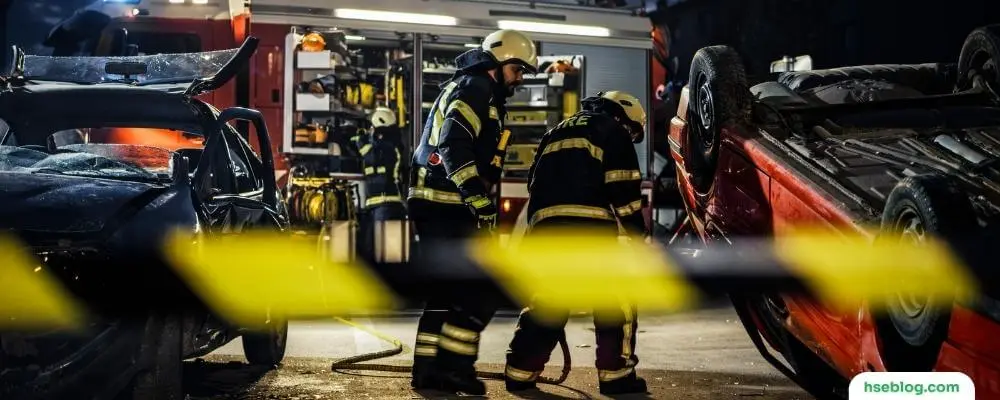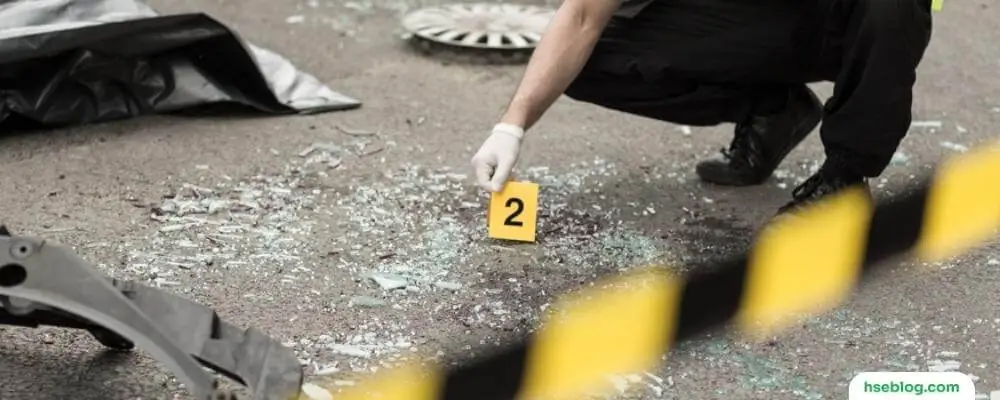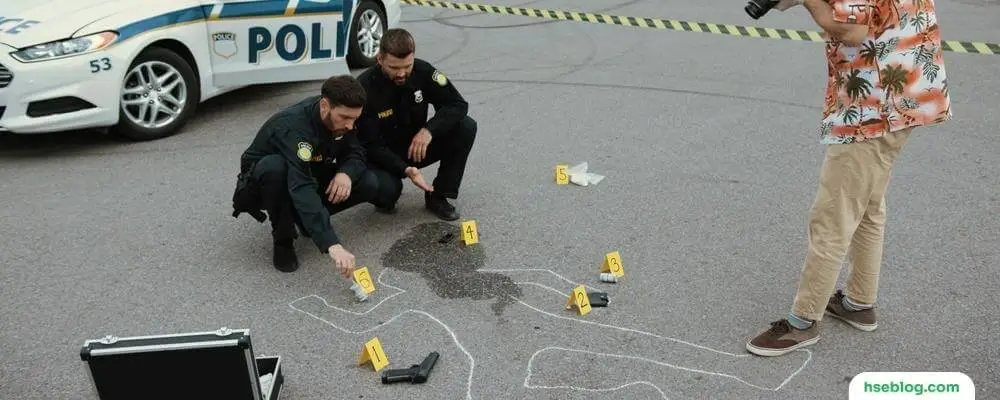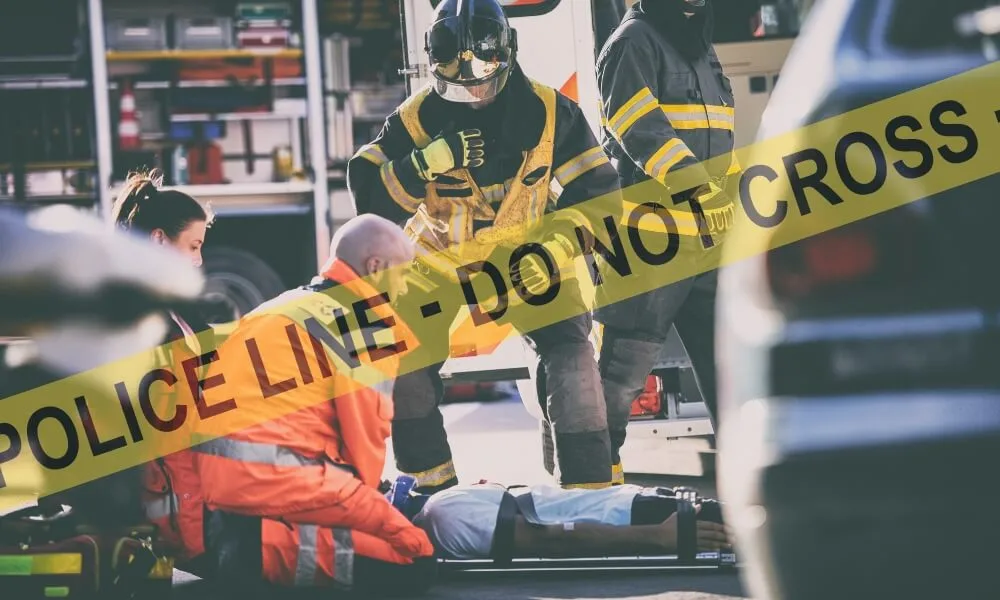The unexpected can happen in any workplace – a slip, a falling object, or a malfunctioning machine. When accidents occur, they can have far-reaching consequences, not just for the victims but for the entire organization. It’s in these critical moments that swift and calculated actions are indispensable. One of the most important actions is securing the scene of the accident. But why is this so important?
This blog delves into the multifaceted significance of securing an accident scene. From ensuring the safety of everyone involved to preserving evidence, facilitating investigations, and complying with legal obligations, securing the scene is a keystone in effective accident management. Whether you are part of the management, an employee, or a safety officer, understanding the importance of this action and how to properly execute it is crucial. Stay with us as we unravel the reasons and best practices for securing the scene of an accident, and learn how to make your workplace a safer environment for all.
Why Is It Important To Secure The Scene Of The Accident?
Securing the scene of an accident is crucial for several reasons. Here are some of the important reasons why it is necessary to secure the scene of an accident:
1. To Ensure The Safety Of Everyone Involved
Securing the scene of an accident at work is imperative to safeguard the well-being of all individuals involved or present in the vicinity. When an accident occurs, there may be risks of additional injuries from hazardous materials, equipment, or a compromised structure. By promptly cordoning off the area, one can prevent unauthorized or unaware personnel from entering a potentially dangerous space and mitigate the risk of exacerbating injuries for those already affected.

2. To Protect The Evidence
Preserving the integrity of the evidence is a critical reason for securing the scene of an accident at work. When an accident happens, understanding the underlying causes is fundamental for preventing future incidents and for legal and insurance purposes.
By cordoning off the area and limiting access, potential contaminants or disturbances are minimized, ensuring that crucial evidence such as machinery positions, debris, or chemical spills remains undisturbed. This allows for a more accurate investigation and analysis by experts, who can then create a comprehensive report of the incident.
3. To Prevent Further Accidents
Securing the scene of an accident is vital in preventing subsequent accidents that could be triggered by the initial incident. For instance, spillage or debris from the accident poses a risk to others who may slip, trip, or come into contact with hazardous materials.
Measures such as displaying warning signs, cordoning off the affected area, and initiating cleanup procedures can be taken by promptly securing the scene. This not only aids in containing the hazards but also alerts other employees or personnel nearby of the potential risks. Through these actions, the likelihood of cascading accidents is significantly reduced, and the overall safety of the workplace is upheld.
4. To Ensure Insurance Coverage
Securing the scene of an accident at work is pivotal in ensuring that insurance coverage is not compromised. Many insurance policies stipulate that reasonable measures must be taken to mitigate damages and prevent further losses after an incident. By securing the scene, you are demonstrating a proactive approach to managing the situation, which includes preserving evidence, safeguarding individuals, and preventing additional accidents.
Insurance companies may view these steps as essential in upholding the terms of the policy, and failure to secure the scene could be construed as negligence, potentially resulting in a denial of claims or increased premiums. Consequently, prompt action in securing the scene is not only a safety measure but a financially prudent one.

5. To Avoid Liability
Securing the scene of an accident is essential in circumventing potential legal liability. When an accident occurs, there is a responsibility, often both legal and ethical, to prevent further harm. If adequate steps are not taken to secure the scene – such as cleaning up spills, blocking off hazardous areas, or ensuring that potentially dangerous equipment is deactivated – someone is injured, or property is damaged. As a result, the entity or individuals responsible for the area may be held liable. This can lead to lawsuits, fines, and reputational damage.
Demonstrating diligence by promptly securing the scene can serve as evidence that reasonable efforts were made to prevent additional injuries or damages, thus helping to mitigate liability.
6. To Maintain Operational Continuity
Securing the scene of an accident is also essential for maintaining operational continuity within the workplace. An unsecured accident scene can cause disruptions, rendering a specific area or equipment unusable and posing risks to the workflow. By taking immediate action to secure the scene, the extent of the disruption can be assessed, and alternative arrangements or contingency plans can be implemented to minimize the impact on productivity.
For example, rerouting foot traffic, temporarily reallocating tasks, or bringing replacement equipment. This enables the organization to resume operations safely and more efficiently while addressing the accident’s aftermath.
7. Ensuring A Thorough Investigation
Ensuring a thorough investigation is a fundamental reason for securing the scene of an accident. A well-conducted investigation is crucial for understanding the incident’s root causes and contributing factors. When the scene is secured, it becomes easier to collect unbiased data, conduct interviews, and analyze the circumstances surrounding the accident without interference or contamination. This leads to more accurate and reliable findings, indispensable for implementing corrective actions, improving safety protocols, and preventing similar incidents.

8. Compliance With Legal And Regulatory Requirements
Securing the scene of an accident is imperative for compliance with legal and regulatory requirements. Various jurisdictions and industries have strict regulations regarding handling accidents, which often include securing the scene. This is not only to ensure safety and protect evidence but also to allow government or regulatory inspectors to examine the scene in its post-accident state. Non-compliance with these regulations can result in severe penalties, including fines, legal sanctions, or even the suspension of business operations.
Moreover, demonstrating adherence to legal and regulatory requirements by securing the scene reflects a commitment to responsible and ethical business practices, which can benefit reputation and stakeholder relations.
9. To Alleviate the Psychological Impact on Employees
Securing the scene of an accident is important for managing the psychological well-being of employees. Witnessing or being involved in a workplace accident can be traumatic for staff. An unsecured scene might be a physical hazard and a continuous psychological trigger for those who witnessed the incident.
By effectively securing the scene, you help to create a physical barrier between the employees and the incident area, which can alleviate anxiety and distress. It also sends a message that the management is taking the incident seriously and taking steps to ensure their safety, which can be crucial for maintaining trust and morale within the workforce.
10. To Facilitate Efficient Communication and Coordination
Securing the scene of an accident plays a significant role in facilitating efficient communication and coordination among various parties involved. In the aftermath of an accident, immediate and well-organized communication between employees, management, emergency services, and possibly regulatory authorities is often needed.
Securing the scene establishes a controlled environment where information can be systematically gathered and shared. It also helps design specific areas for different teams, such as a location for first aid or an area for investigators to convene. This organized approach ensures that all parties can work in tandem without confusion or miscommunication, leading to a more effective response to the incident.

Best Practices For Securing And Documenting An Accident Scene
Securing and documenting an accident scene are critical components of accident response and investigation. Following best practices ensures the scene is safe, evidence is preserved, and relevant information is collected for analysis.
- Prioritize Safety: The first step in securing an accident scene is to ensure the safety of all individuals involved. This may include administering first aid, evacuating the area, or shutting down equipment.
- Establish a Perimeter: Use cones, tapes, or barriers to establish a clear perimeter around the accident scene. This will help control access to the area and prevent scene contamination.
- Communicate Clearly: Notify all relevant parties, including management, employees, and emergency services if needed. Use clear and concise communication to convey the nature of the accident and the steps being taken.
- Preserve Evidence: Take steps to preserve physical evidence at the scene. This might include not moving vehicles or equipment involved in the accident unless necessary for safety and leaving all objects as they were at the time of the accident.
- Document the Scene: Take photographs and videos of the scene from multiple angles. Capture images of any machinery, vehicles, substances, or environmental conditions that may have played a role in the accident.
- Collect Witness Statements: Identify and interview anyone who may have witnessed the accident. Record their statements, and include their names and contact information for follow-up.
- Make a Detailed Record: Write a detailed account of the scene. Include the date, time, and location of the accident. Describe the events leading up to the accident and what occurred during and after the incident.
- Implement Temporary Controls: If the accident scene poses ongoing risks, implement temporary controls to mitigate them. This may include cleaning up spills, propping up unstable structures, or posting warning signs.
- Report to Regulatory Authorities: If the accident requires reporting to regulatory authorities, ensure this is done according to the applicable regulations.
- Follow Up and Monitor the Scene: After the initial securing and documenting of the accident scene, it’s important to monitor the area for safety and ensure no further evidence is disturbed until the investigation is complete.
Remember, the main objectives in securing and documenting an accident scene are ensuring safety, preserving evidence, and collecting information that will be critical in understanding and preventing similar incidents in the future.
Conclusion
In conclusion, securing the scene of an accident is an indispensable practice that serves as the foundation for a cascade of pivotal actions and processes. It is the linchpin in ensuring the safety and well-being of individuals, preserving critical evidence, facilitating a thorough investigation, and upholding compliance with legal and regulatory requirements.
Additionally, it aids in safeguarding organizational interests, such as insurance coverage, maintaining operational continuity, and mitigating liability. By understanding and effectively implementing the measures to secure an accident scene, we contribute to creating a safer, more responsible, and resilient work environment, which is imperative for the welfare of individuals and the sustainability of organizations.

